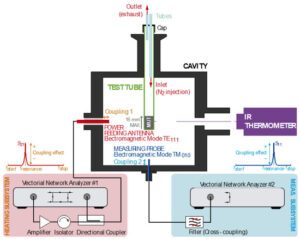
Many efforts are being made to find innovative ways of recycling rubber from end-of-life tires (ELTs), also called ground tire Rubber (GTR). Recycling through devulcanization allows the reintroduction of rubber back into the manufacturing industry. Such a process requires providing enough energy to break the sulfur links, while preventing damage to the polymeric chain. Microwave heating is controllable, efficient, and it does not rely on conventional heating mechanisms (conduction, convection) which may involve high heating losses, but rather on direct dielectric heating. However, to adequately control the microwave-assisted devulcanization performance, a thorough knowledge of the GTR permittivity versus temperature is required. In this work, GTR permittivity was monitored during its devulcanization. A resonant technique based on a dual-mode cylindrical cavity was used to simultaneously heat rubber and measure its permittivity at around 2 GHz. The results show sharp changes in the GTR permittivity at 160 and 190 °C. After the GTR cooled down, a shifted permittivity evidences a change in the GTR structure caused by the devulcanization process. Microwave-assisted devulcanization effectiveness is proven through time-domain nuclear magnetic resonance (NMR) measurements, by verifying the decrease in the cross-link density of processed GTR samples compared to the original sample.
Rafael Pérez Campos1, José Fayos Fernández1, Juan Monzó Cabrera1, Fernando Martín Salamanca, Juan López Valentín, José Manuel Catalá Civera2, Pedro Plaza González2, Juan Rafael Sánchez Marín2
Departamento de Tecnologías de la Información y las Comunicaciones, Universidad Politécnica de Cartagena (UPCT), 30202 Cartagena, España
Rafael Pérez Campos1, José Fayos Fernández1, Juan Monzó Cabrera1, Fernando Martín Salamanca, Juan López Valentín, José Manuel Catalá Civera2, Pedro Plaza González2, Juan Rafael Sánchez Marín2
Departamento de Tecnologías de la Información y las Comunicaciones, Universidad Politécnica de Cartagena (UPCT), 30202 Cartagena, España
2 Instituto de Tecnologías de la Información y las Comunicaciones, Universitat Politècnica de València (UPV), 46022 Valencia, España

![Read more about the article Poly(ε-caprolactone) Diols (HOPCLOH) and Their Poly(ester-urethanes) (PEUs): The Effect of Linear Aliphatic Diols [HO–(CH2)m–OH] as Initiators](http://www.elastomeros.ictp.csic.es/wp-content/uploads/2017/04/lpte_a_1247273_uf0001_oc-300x110.jpg)